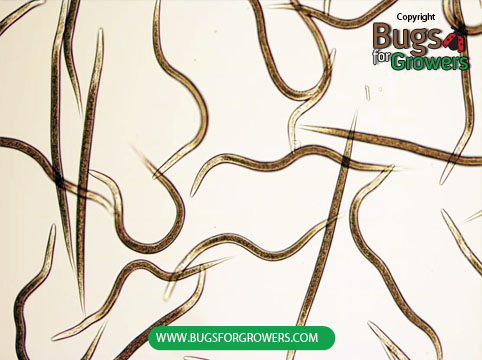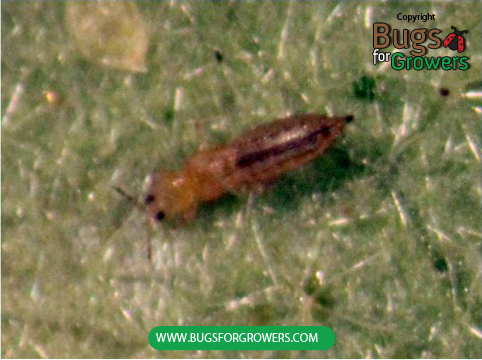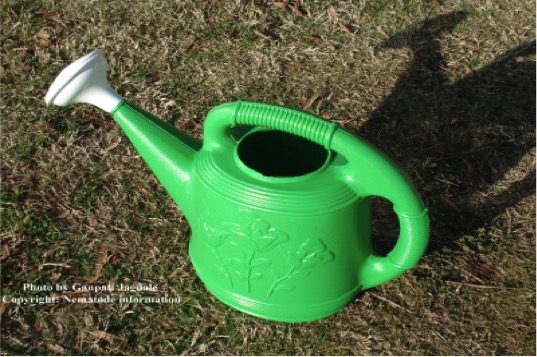What are beneficial entomopathogenic Steinernema carpocapsae nematodes?
Beneficial entomopathogenic Steinernema carpocapsae nematodes are microscopic and thread like roundworms (Photo 1). Since these nematodes are pathogenic to insect pests, they are called entomopathogenic nematodes. These nematodes are also called beneficial nematodes because they are currently used as successful biological control agents for the management of many species of thrips. Steinernema carpocapsae nematodes are also not harmful to pets and humans.

What are thrips?
Thrips are about 1-2 mm long, slender and soft bodied insects. There are several species of thrips (see below) that exist in nature. Depending on the species, thrips can be yellowish, blackish, whitish or dark brownish in color. Adult thrips have hair-fringed wings but their immature young stages (nymphs) are wingless (Photo 2). The male thrips are slightly smaller than the female thrips. Both adults and nymphs have rasping and sucking type of mouthparts that they use for puncturing and sucking cell sap (juice) from the punctured plant tissue.
Species of thrips: Different species of thrips are commonly named after their host plants. For example,
- The avocado thrips, Scirtothrips perseae
- The bean thrips, Caliothrips fasciatus
- The corn thrips, Frankliniella williamsi
- The citrus thrips, Scirtothrips citri
- The Florida flower thrips, Frankliniella bispinosa
- The greenhouse thrips, Heliothrips haemorrhoidalis
- The maize thrips, Frankliniella williamsi
- The melon thrips, Thrips palmi
- The onion thrips, Thrips tabaci
- The soybean thrips, Sericothrips variablilis
- The tobacco thrips, Frankliniella fusca
- The Tomato thrips, Frankliniella schultzei
- The western flower thrips, Frankliniella occidentalis

Damage caused by thrips
Thrips are economically important insect pests of many greenhouse and field crops, ornamental plants, and fruits. Both adults and nymphs use their rasping and sucking types of mouthparts for feeding and damaging young leaves, flowers and fruits. The major symptoms of heavy feeding damage by thrips include stunted plant growth, curling/folding (Photo 3), stippling, and discoloration of leaves, flower buds and flowers. The damaged leaves and flower petals generally drop prematurely. Also, the scattered thrip feces on the leaves and flowers can reduce aesthetic value and marketability of ornamental plants. Thrips are also known to transfer plant viruses that are responsible for causing severe economic losses to many crops and ornamental plants.

How beneficial entomopathogenic Steinernema carpocapsae nematodes can kill thrips?
When the infective juveniles of Steinernema carpocapsae nematodes are applied to the surface of plant growing medium or injected in the potting medium, they search and locate larval, pre-pupal and pupal stages of thrips. The nematodes then enter into the body cavity of larvae, pre-pupae and pupae of thrips via their natural openings such as mouth, anus and spiracles. Once in the body cavity, nematodes release symbiotic bacteria (Xenorhabdus spp.) from their gut in the blood of larvae, prepupal and pupal stages of thrips. In the blood, these bacteria multiply quickly and cause septicemia that kills all the stages of thrips usually within 48 h after infection.
How to apply Steinernema carpocapsae nematodes?
Beneficial entomopathogenic Steinernema carpocapsae nematodes are easy to apply. These nematodes are commercially sold either in gel or granular formulations. For application of nematodes either in pots or beds, dissolve these formulations in water. Then apply this nematode suspension as drench to the surface of the plant growing medium using a small water can (Photo 4).

How many Steinernema carpocapsae nematodes should be applied?
The optimum rate for the effective control of thrips would be about 1000 infective juvenile of Steinernema carpocapsae nematodes per gallon pot or 23,000 infective juvenile of Steinernema carpocapsae nematodes per square foot area. You can use the following table for applying appropriate rates of nematodes to cover specific sizes of thrip infested areas.
Area in sq. ft. = Number of nematodes required
1sqft = 23,000 nematodes
100 sqft = 2,300,000 nematodes
500 sqft = 11,500,000 nematodes
1,000 sqft = 23,000,000 nematodes
43,560 sqft (1 Acre) = 1,000,000,000 nematodes
